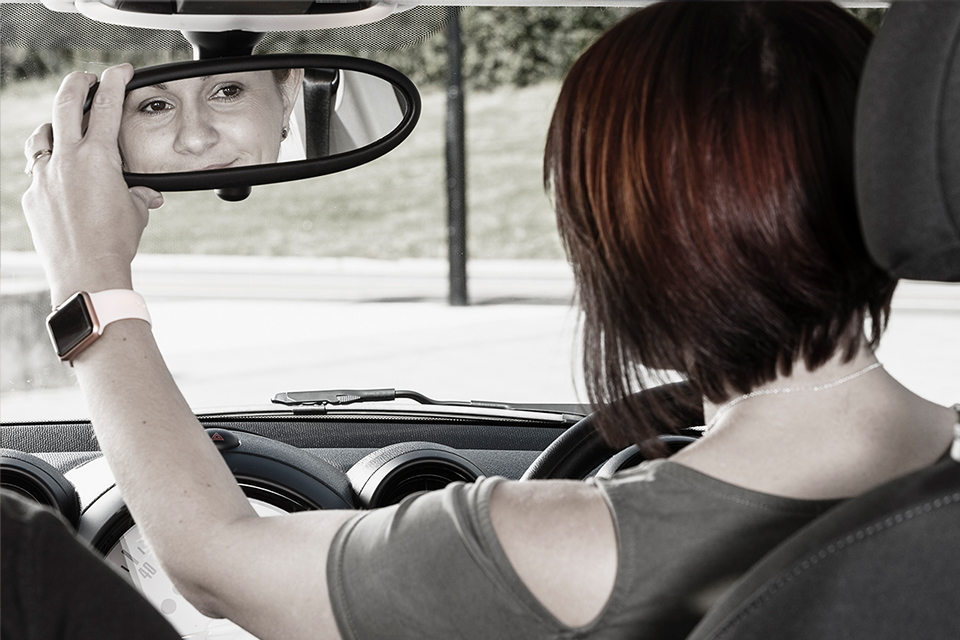There are many potential dangers on the road, and missing things in your blind spots is a factor in many car accidents in the UK. Blind spots are areas that are obscured from your view in the driver’s seat, and big enough to hide entire vehicles. They pose a particular danger when you set off from standstill and when you change lanes, because you might not see cars, bikes and motorbikes as they come up alongside you.
But it’s not all bad news: checking your blind spots when you’re driving is actually pretty simple, and an easy way to prevent possible collisions. To help make you a safer driver—and to help you coast your driving test—we’re here to teach you where your blind spots are, and when and how to check them.
What are your blind spots when driving?

Although your mirrors (if they’re set up correctly) show most of what’s going on behind you, there are zones they don’t quite reach. You car can also hide sections of the road from view. These are your blind spots: areas that you can’t see, either directly or through your mirrors.
There are two main blind spots that all cars have, although the size of them varies depending on the size and build of your vehicle.
– Diagonally behind you. You can see vehicles that are further back in or rear or side mirrors, but as traffic pulls up in a lane alongside you, they are hidden from view.
– Diagonally in front of you. Your car’s bodywork, for example the A-pillars either side of your windscreen, obscure your vision.
When should I check my blind spots?

As a driver, you should always remain aware of your surroundings. You can usually do this through a combination of keeping your eyes on the road ahead and regularly checking your mirrors.
However, there are particular times when it’s important to turn your head and make sure there’s nothing in your blind spots. These are:
– Before setting off. You need to make sure that you won’t be moving off directly into someone else.
– Before changing lanes. Whether you’re overtaking or getting into the right lane for a junction, drivers or cyclists may have pulled up alongside you. On multi-lane roads like motorways, people behind you might also be changing lanes, so the situation can change very quickly; it’s not enough to just look in your mirrors and hope for the best.
– When other vehicles are merging into your lane. Drivers wanting to pull out from slip roads, or otherwise merging into your lane, need a clear gap in which to do this. You need to check that you’re not blocking someone’s entry onto your lane. If you are, you should adapt your speed or change lanes accordingly.
– Turning into a side road. You should perform a blind spot check before you turn off a road, particularly when you have recently overtaken a cyclist. Otherwise, if the cyclist is close behind you, you might collide with them as they go straight on.
– At junctions. Your A-pillars may conceal traffic coming from the left or right. Make sure you make proper observational checks before turning.
How do I check my blind spots?

It’s easy enough to check your blind spots: just look over your shoulder.
Make sure the road is clear:
– Out of your window, and
– Out of the back passenger window.
Practice turning your head when you’re stationary in the driver’s seat, so that you know where you’re meant to be looking once you’re on the move. It’ll soon become a natural part of your normal observation routine.
Moving off
Before moving off from the side of the road, you should check all around you. During your driving lessons, you’ll be taught to do this in a clockwise rotation. You should look:
Over your left shoulder
↓
In your left wing mirror
↓
In the rear view mirror
↓
In your right wing mirror
↓
Over your right shoulder
After an emergency stop
You don’t always have time to check your mirrors before an emergency stop. That’s why you should take particular care to check both blind spots and your mirrors before moving off again.
Setting off again after sitting in traffic
You should check all 3 mirrors before moving off in traffic. In this case, you don’t need to check over your shoulders into your blind spots, but do be aware of cyclists or motorcyclists who may have ridden up alongside you while you’ve been stopped.
At junctions
At junctions, the pillars either side of your windscreen obstruct your vision.
– Slow down on your approach, so that you can perform the proper observational checks.
– Move your head slightly forwards to see beyond your A-pillars into the blind spots.
– Check left and right at least twice to give any vehicles time to move into your line of vision.
When moving
Usually when you’re driving, we advocate facing forwards. Turning your head too much can mess with your lane positioning. That’s why we have mirrors: so you can check behind you with a quick glance, and keep a general eye on what’s going on.
However, sometimes a mirror check isn’t enough. When you’re changing lanes or other traffic is merging into your lane, you should look both in your mirrors and over your shoulder in the relevant direction to check your blind spot:
First check your rearview mirror
↓
Next look in the appropriate wing mirror
↓
Finally, glance over your shoulder.
That should cover all of the area behind you, so you can safely change lanes without cutting anybody up.
Checking your blind spots during the driving test
If you don’t check your blind spots when moving off during your driving test, you will receive a fault. If you’re in a position that means your failure to check is potentially dangerous, you’ll get a serious fault—meaning an automatic fail.
